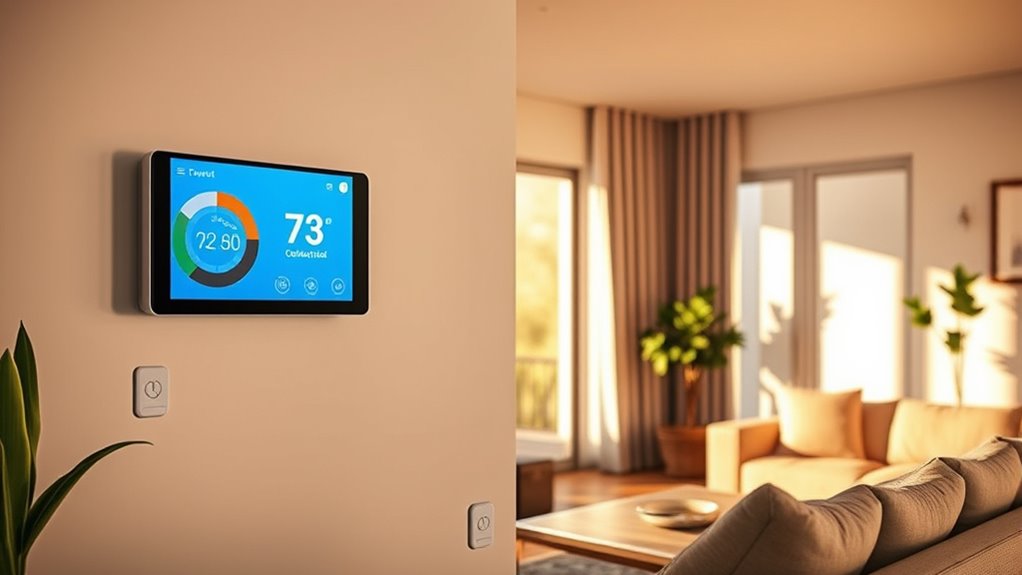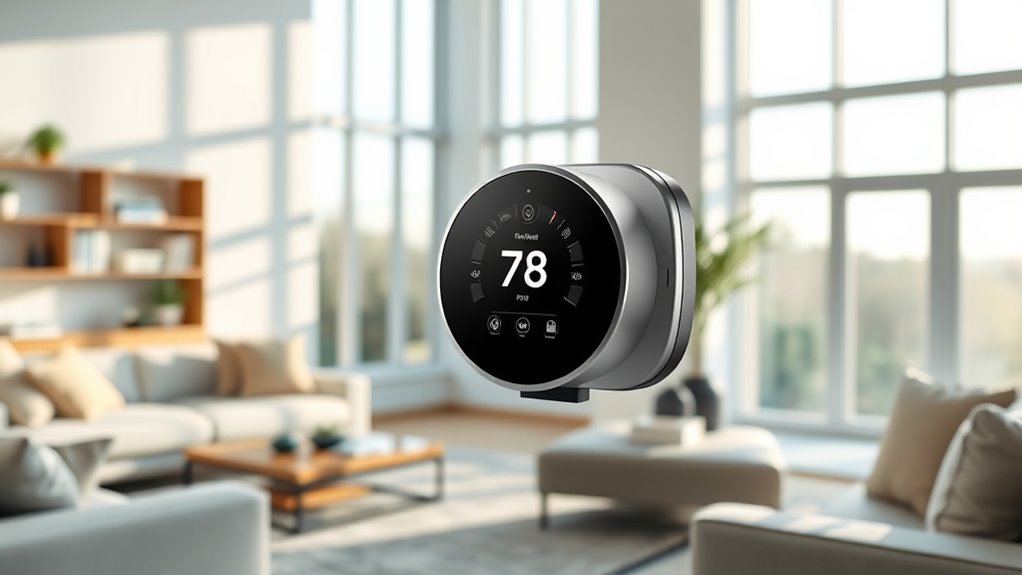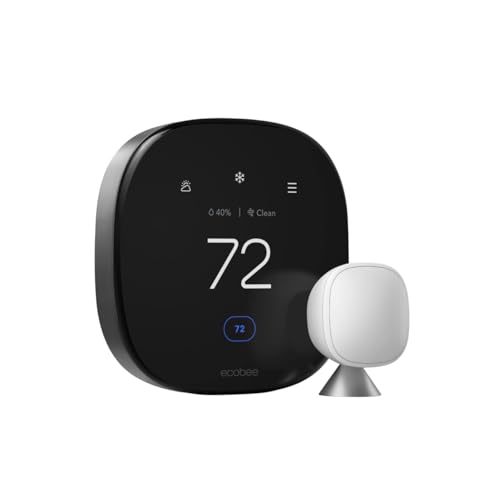I’ve researched the top 15 smart thermostats with remote sensors that can really improve home comfort and save energy. These devices offer features like zone-specific control, easy integration with voice assistants, and simple installation—some even don’t need a C-wire. They help eliminate hot or cold spots and let me control my climate from anywhere. If you want to discover which models fit your needs perfectly, there’s a lot more to explore ahead.
Key Takeaways
- Many top smart thermostats support multiple remote sensors for room-specific temperature control and enhanced comfort.
- Features like adaptive scheduling, geofencing, and energy reports optimize home climate and reduce costs.
- Compatibility varies with HVAC systems; some models are easier to install, even without a C-wire.
- Integration with voice assistants and smart home ecosystems ensures seamless remote management.
- Proper sensor placement and compatibility are essential for accurate climate control and eliminating hot or cold spots.
ecobee Smart Thermostat Premium with Sensors
If you’re looking to maximize energy savings and guarantee consistent comfort throughout your home, the ecobee Smart Thermostat Premium with Sensors is an excellent choice. I’ve found it reduces heating and cooling costs by up to 26% annually and features a built-in air quality monitor that detects poor conditions and reminds you to change filters. The included SmartSensor adjusts room temperatures to eliminate hot or cold spots and detects open windows or doors, pausing HVAC to save energy. With compatibility across various systems, voice control, and remote app access, it’s a smart, user-friendly device that enhances both comfort and efficiency.
Best For: homeowners seeking to maximize energy savings, improve air quality, and enjoy seamless smart home integration through an easy-to-use, versatile thermostat.
Pros:
- Up to 26% annual reduction in heating and cooling costs, leading to significant energy savings
- Built-in air quality monitor and SmartSensor for optimal comfort and elimination of hot or cold spots
- Compatibility with various HVAC systems and integration with voice assistants like Alexa, Siri, and Google Assistant
Cons:
- Installation can be complex, often requiring professional assistance or wiring upgrades
- Some users report initial setup challenges with voice assistant integration and app configuration
- Placement of sensors and setup may be tricky for visually impaired users or in homes with limited space
T9 WiFi Smart Thermostat with Room Sensor
The T9 WiFi Smart Thermostat with Room Sensor is an excellent choice for homeowners seeking precise comfort control and energy savings. It’s ENERGY STAR certified, helping you cut costs and energy usage. You can control it remotely via the app or set Auto Home/Away Scheduling for automatic adjustments. The smart sensors detect occupancy and focus heating or cooling where needed, even across rooms up to 200 feet away. Compatible with various systems like forced air, hot water, and heat pumps, it offers flexible, multi-room comfort management. Plus, it integrates seamlessly with Alexa, Google Assistant, and Apple HomeKit for voice control.
Best For: homeowners seeking precise, energy-efficient comfort control with smart room sensing and remote management capabilities.
Pros:
- ENERGY STAR certified for energy savings and utility rebate opportunities
- Smart sensors detect occupancy and focus comfort where needed across multiple rooms
- Compatible with a variety of heating systems and voice assistants for flexible control
Cons:
- Requires a C-wire for installation in most cases
- Not compatible with electric baseboard heating systems (120-240V)
- DIY installation may be challenging for some users without prior experience
Smart Thermostat with Room Sensor and Touchscreen Control
A smart thermostat with room sensor and touchscreen control is ideal for homeowners seeking precise temperature management and easy, intuitive operation. The Provirtec TH-01 supports most 24VAC HVAC systems, offering features like a large 3.95-inch LED touchscreen, programmable schedules, and modes for energy savings. It connects via WiFi and Bluetooth, allowing remote control through the Prodigytec app. The thermostat includes a room sensor for auto-adjustment based on body location. Its sleek design and simple touch interface make it user-friendly. While installation is straightforward with a C-wire, some users face wiring and app setup challenges, but overall, it balances functionality and affordability well.
Best For: homeowners seeking a user-friendly, programmable smart thermostat compatible with most 24VAC HVAC systems for precise temperature control and energy savings.
Pros:
- Large 3.95-inch LED touchscreen for easy temperature adjustments and clear display
- Supports remote control via WiFi and Bluetooth with the Prodigytec app for convenient management
- Includes a room sensor for auto-adjustment based on body location, enhancing comfort and efficiency
Cons:
- Some users experience wiring compatibility issues, especially with 6-wire setups
- App interface and setup procedures can be less intuitive, leading to initial user frustration
- Limited Bluetooth functionality reported by some users, affecting local control options
Sensi Touch 2 Smart Thermostat with Touchscreen Display
For homeowners seeking a sleek, user-friendly smart thermostat that offers precise control and energy savings, the Sensi Touch 2 stands out. Its 5.6″ color touchscreen makes navigation simple, while compatibility with most HVAC systems guarantees easy installation. It works seamlessly with Amazon Alexa, Google Assistant, and Samsung SmartThings, plus supports room sensors for better zone management. The device can cut energy use by about 23% with customizable schedules, geofencing, and remote control. Its intuitive app guides DIY setup, and the device’s privacy focus and reliable performance make it a smart upgrade for modern homes.
Best For: homeowners seeking an easy-to-install, energy-efficient smart thermostat with a sleek touchscreen interface and smart home compatibility.
Pros:
- User-friendly 5.6″ color touchscreen display for intuitive control
- Compatible with major smart home platforms like Alexa, Google Assistant, and Samsung SmartThings
- Supports room sensors and customizable schedules to optimize comfort and energy savings
Cons:
- Requires a common C-wire for power installation, which may be unavailable in some homes
- Initial Wi-Fi setup can be challenging and involve managing PIN codes during connection
- Limited advanced customization options compared to more complex thermostats
Google Nest Thermostat and Sensor Bundle
If you want a sleek, highly customizable smart thermostat that learns your routines and saves energy, the Google Nest Thermostat and Sensor Bundle is an excellent choice. Its modern design features a polished Obsidian finish and a bright, large touchscreen with Dynamic Farsight, making it easy to view from across the room. Compatible with most 24V systems and various smart home platforms, installation is quick and straightforward. The thermostat adapts to your habits, adjusting temperatures automatically, while the included remote sensor allows precise control in different rooms. With voice control support and energy-saving features, this bundle offers both style and functionality for a smarter, more efficient home.
Best For: homeowners seeking a stylish, easy-to-install smart thermostat that adapts to their routines and offers precise control with energy-saving features.
Pros:
- Sleek, modern design with customizable display options and bright touchscreen for easy viewing
- Learns routines over time to optimize comfort and save on energy bills
- Compatible with most 24V systems and integrates seamlessly with popular smart home platforms
Cons:
- Higher price point compared to earlier models and some competitors
- Compatibility limitations in certain regions, such as the UK
- Requires batteries (CR2) and Wi-Fi connection for full functionality
RCHTSENSOR-1PK, Smart Room Sensor works with T9/T10 WIFI Smart Thermostats
The RCHTSENSOR-1PK Smart Room Sensor is an excellent choice for homeowners using Honeywell’s T9/T10 Wi-Fi smart thermostats who want precise, room-specific climate control. It’s compatible with Series 3 and Series 4 T9 models, making it suitable for modern setups. Installation is simple—just insert the batteries, mount on a wall or place on a tabletop, and connect via the Resideo app. The sensor detects temperature, humidity, and motion, enabling focused comfort based on occupancy. It’s highly rated for ease of use and effective zone control, but compatibility issues may arise with older models, so verifying your thermostat version before purchasing is recommended.
Best For: homeowners with Honeywell T9/T10 Wi-Fi smart thermostats seeking precise, room-specific climate control and easy installation.
Pros:
- Easy to install with no tools required, just insert batteries and mount or place on a surface
- Detects temperature, humidity, and motion to enable focused zone control and improved comfort
- Compatible with Series 3 & 4 T9 models and supports integration with Alexa, Google Assistant, Apple Home, and more
Cons:
- Compatibility issues with older T9 models may prevent proper operation; verification needed before purchase
- Motion detection can be limited if occupants remain still, reducing effectiveness in some scenarios
- Some users report difficulties with customer support and firmware compatibility affecting device performance
ecobee Smart Thermostat Essential with Wi-Fi
The ecobee Smart Thermostat Essential with Wi-Fi stands out as an excellent choice for homeowners seeking an energy-efficient and easy-to-install thermostat that seamlessly integrates with popular smart home platforms. It’s Energy Star certified and compatible with Siri, Alexa, Google Assistant, and Apple HomeKit, making control effortless. Its sleek, round design features a color LCD touchscreen and intuitive touch controls. The thermostat supports most 24 VAC systems, including gas, electric, and heat pumps, and can save you up to 23% annually on heating and cooling costs. Installation is straightforward, even DIY, with no C-wire needed, and setup is guided via the ecobee app.
Best For: homeowners seeking an energy-efficient, easy-to-install smart thermostat with seamless smart home integration and flexible control options.
Pros:
- Compatible with major smart home platforms including Siri, Alexa, Google Assistant, and Apple HomeKit
- No C-wire needed for installation, making DIY setup simple and quick
- Helps save up to 23% annually on heating and cooling costs, providing substantial energy savings
Cons:
- Some users experience wiring complexities during installation
- Customer support communication issues have been reported by a few customers
- Advanced troubleshooting may require additional support or technical knowledge
Amazon Smart Thermostat
Designed for budget-conscious homeowners seeking reliable smart home control, the Amazon Smart Thermostat offers straightforward installation and seamless integration with Alexa. Compatible with most 24V HVAC systems, it supports features like humidity sensing, scheduling, and energy insights. Setup takes about an hour via the Alexa app, often using a C-wire or transformer if needed. Priced around $60, it’s an affordable option, with rebates sometimes covering the full cost. Users praise its automation, remote control, and voice commands, though some experience Wi-Fi or app issues. Overall, it’s a dependable, cost-effective choice that helps reduce energy bills while enhancing home comfort.
Best For: budget-conscious homeowners seeking reliable, easy-to-install smart thermostats with Alexa integration and energy-saving features.
Pros:
- Affordable price point around $60 with potential rebates covering the full cost
- Easy, guided installation typically completed within an hour
- Seamless compatibility with most 24V HVAC systems and strong app control features
Cons:
- Occasional Wi-Fi reconnection issues after power outages or during app updates
- Some users experience app crashes or delays in scheduling features on older devices
- Not compatible with 110-240V systems like electric baseboard heat
Honeywell Home T9 Smart Thermostat with Room Sensor (Renewed)
If you’re looking to optimize comfort and energy savings in a smart home, the Honeywell Home T9 Smart Thermostat with Room Sensor (Renewed) is a solid choice for tech-savvy homeowners who want precise temperature control. It works with various heating systems like forced air, hot water, steam, and heat pumps, and uses Smart Room Sensors to focus on specific zones. The thermostat can be managed via the Resideo app or voice assistants like Alexa and Google Assistant. While installation may require some technical know-how, users report improved temperature consistency and energy efficiency. Keep in mind, setup and Wi-Fi connectivity can be challenging, especially on complex networks.
Best For: tech-savvy homeowners seeking precise zone-based temperature control and energy savings with advanced smart features.
Pros:
- Compatible with a variety of heating systems including forced air, hot water, steam, and heat pumps
- Uses Smart Room Sensors for focused temperature management and occupancy detection
- Integrates seamlessly with voice assistants like Alexa, Google Assistant, and Apple HomeKit
Cons:
- Installation and setup may require technical expertise, especially network configuration
- Wi-Fi connectivity issues are common, particularly on complex or enterprise networks
- Requires a C-wire for installation; some users may need additional wiring or adapters
Google Nest Thermostat E Bundle
For homeowners seeking an easy-to-install smart thermostat that combines energy savings with room-specific control, the Google Nest Thermostat E Bundle stands out. It learns your preferred temperatures, automatically adjusting to save energy and boost comfort. Home/Away Assist switches to Eco Temperature when you’re out, preventing waste. Compatible with various heating systems, including boilers and heat pumps, it offers remote control via phone, tablet, or laptop. The included Google Nest Temperature Sensor detects room temperatures, allowing you to manage specific areas. Installation takes about an hour, and the sleek design blends seamlessly into home decor. Energy history and efficiency indicators help maximize savings over time.
Best For: homeowners seeking an easy-to-install, energy-efficient smart thermostat with room-specific control and remote access.
Pros:
- Learns your preferred temperatures and automatically adjusts to save energy
- Compatible with a wide range of heating and cooling systems, including boilers and heat pumps
- Features remote control via phone, tablet, or laptop for convenience
Cons:
- Installation, while straightforward, may still require basic technical skills for some users
- Limited to heating systems; does not support cooling-only setups
- The design, while sleek, may not match all home decor styles
Sensi Smart Thermostat with Wi-Fi and Alexa Compatibility
The Sensi Smart Thermostat with Wi-Fi and Alexa compatibility stands out as an excellent choice for homeowners seeking an easy-to-install, energy-efficient thermostat that integrates seamlessly with voice assistants. It features a sleek design, a 5-inch LED display, and simple wiring, often eliminating the need for a C-wire. Compatible with most HVAC systems, including air conditioners, furnaces, and heat pumps, it offers remote control via a mobile app and supports voice commands through Alexa and Google Assistant. With Energy Star certification, it helps save up to 23% on energy costs. Its intuitive setup and reliable performance make it a smart addition to any modern home.
Best For: homeowners seeking an easy-to-install, energy-efficient smart thermostat that integrates seamlessly with voice assistants and modern smart home platforms.
Pros:
- Easy DIY installation with minimal wiring, often eliminating the need for a C-wire
- Compatible with a wide range of HVAC systems including air conditioners, furnaces, and heat pumps
- Supports remote control via mobile app and voice commands through Alexa and Google Assistant
Cons:
- Some users experience delays in system response, such as boiler activation taking 20-25 seconds
- Usage reports are limited to daily runtime data without detailed historical or timing information
- Does not work with Bixby and may require manual adjustments for optimal system performance
LEVOIT Smart Thermostat for Home, WiFi Programmable Digital Thermostat
The LEVOIT Smart Thermostat stands out for homeowners seeking customizable comfort and energy savings, thanks to its support for up to 16 remote sensors. I appreciate how it helps create a greener home by enabling routines that conserve energy when we’re away, with daily energy reports to track savings. Its compatibility with Alexa and Google Assistant means I can control it with my voice, and the VeSync app lets me manage it remotely from anywhere. The easy DIY installation, including a C-wire adapter, makes setup simple. With features like 24/7 scheduling and a bright touchscreen display, it offers both convenience and precise climate control.
Best For: homeowners seeking customizable, energy-efficient climate control with remote access and smart home integration.
Pros:
- Supports up to 16 remote sensors for room-specific comfort monitoring.
- Compatible with Amazon Alexa and Google Assistant for voice control.
- Easy DIY installation with included C-wire adapter and a user-friendly touchscreen display.
Cons:
- Higher Eco level settings may sacrifice precise temperature control for energy savings.
- Requires WiFi connection for remote management and smart features.
- Some users may find the setup of multiple sensors and integration process complex.
ecobee Smart Thermostat Enhanced, Programmable Wi-Fi Thermostat
If you’re looking for a smart thermostat that seamlessly integrates with various smart home systems and offers energy-saving features, the ecobee Smart Thermostat Enhanced is an excellent choice. It works with Siri, Alexa, Google Assistant, Apple HomeKit, SmartThings, and IFTTT, making setup flexible. With its programmable Wi-Fi control and Energy Star certification, it can save up to 26% annually on heating and cooling costs. The device supports most HVAC systems, including gas, electric, oil, dual fuel, and heat pumps. Easy to install with a Power Extender Kit, it features a sleek LCD display and app control, offering both convenience and efficiency.
Best For: homeowners seeking a versatile, energy-efficient smart thermostat compatible with multiple smart home platforms and HVAC systems.
Pros:
- Compatible with most HVAC systems and popular smart home assistants including Siri, Alexa, Google Assistant, and Apple HomeKit.
- Offers energy savings of up to 26% annually through intelligent temperature adjustments and occupancy-based controls.
- Easy to install with a Power Extender Kit and features a sleek LCD display for intuitive control.
Cons:
- Installation may be complex for systems without a C-wire, sometimes requiring professional assistance.
- Initial setup can pose challenges for users with complex HVAC configurations or compatibility issues.
- Customer feedback indicates occasional delivery or model compatibility issues, requiring verification before purchase.
Google Nest Thermostat, Programmable Wi-Fi Smart Thermostat
For homeowners seeking an easy-to-use, energy-efficient thermostat that can be controlled remotely, the Google Nest Thermostat is an excellent choice. It’s ENERGY STAR certified, designed to save energy and boost comfort. Compatible with many HVAC systems, you just need to check compatibility with the Nest Compatibility Checker. It connects via dual-band Wi-Fi and Bluetooth Low Energy, and most homes won’t require a C wire. Using the Google Home app, I can set schedules, monitor system health, and receive maintenance alerts from anywhere. Its auto-away feature reduces energy waste when I’m away, making it both smart and practical for everyday home climate control.
Best For: homeowners seeking an easy-to-use, energy-efficient, and remotely controllable smart thermostat that enhances home comfort and saves energy.
Pros:
- ENERGY STAR certified for energy savings and environmental efficiency
- Compatible with many HVAC systems and easy to install without a C wire in most homes
- Remote control and scheduling via the Google Home app for convenience and customization
Cons:
- No lock feature to prevent unauthorized adjustments
- Some complex HVAC systems may require additional accessories or professional installation
- Limited to Wi-Fi and Bluetooth connectivity, which may affect performance if network issues occur
T9 WiFi Smart Thermostat with Room Sensor and Touchscreen
Anyone looking to optimize home comfort and energy savings will appreciate the T9 WiFi Smart Thermostat with Room Sensor and Touchscreen. It offers detailed Monthly Energy Reports, adaptive scheduling, and integrates with utility efficiency programs, helping you conserve energy and earn seasonal rewards. Compatible with most heat/cool systems—excluding electric baseboard heat—it’s easy to install with a C-wire and included power adapter. The touchscreen makes setup simple, and features like auto Home/Away mode, smart response learning, and remote control via mobile ensure maximum comfort. Plus, adding Smart Room Sensors lets you focus temperature control on multiple rooms, enhancing overall comfort.
Best For: homeowners seeking an energy-efficient, easy-to-install smart thermostat with customizable multi-room comfort and remote control features.
Pros:
- Offers detailed Monthly Energy Reports and adaptive scheduling to optimize energy use
- Compatible with most heat/cool systems (excluding electric baseboard heat) and easy to install with included components
- Features a touchscreen display, auto Home/Away mode, and smart response learning for personalized comfort
Cons:
- Not compatible with electric baseboard heating systems
- Requires a C-wire for installation, which may not be available in all homes
- Smart Room Sensors are sold separately, adding extra cost for multi-room control
Factors to Consider When Choosing Smart Thermostats With Remote Sensors

When choosing a smart thermostat with remote sensors, I consider how well the sensors will work with my existing system. I also look at installation ease, sensor range, and placement options to guarantee ideal coverage. Understanding these factors helps me select a setup that’s both effective and simple to maintain.
Sensor Compatibility Requirements
Choosing the right smart thermostat with remote sensors hinges on ensuring compatibility. First, I check if the sensors are compatible with my specific thermostat model, as some only work with certain generations or series. I also verify the communication protocol—whether Zigbee, Z-Wave, or Wi-Fi—to ensure seamless integration with my existing setup. It’s important to confirm that the sensors accurately detect temperature, humidity, and occupancy in the rooms I want to monitor. I also look at the range, typically around 200 feet, to make sure the sensors will connect reliably throughout my home. In conclusion, I confirm that the sensors are compatible with my smart home ecosystem and can be managed through the same app or platform, simplifying control and automation.
Installation Complexity Levels
Installing a smart thermostat with remote sensors can vary in complexity depending on your home’s existing wiring and system setup. Some models only need a simple C-wire adapter, making installation straightforward, especially with plug-and-play options and clear instructions. Homes with common 24VAC systems often face fewer challenges. If your wiring is more complex or older, you might need additional components like Power Extender Kits or low-voltage adapters to simplify connections. In some cases, especially with multi-zone or complex wiring, professional installation is advisable to guarantee compatibility and proper setup. Units that offer detailed wiring guides, step-by-step app instructions, and support resources tend to make installation easier and faster. Evaluating your system’s wiring complexity helps you choose a thermostat that fits your technical comfort level.
Sensor Range Limitations
The effectiveness of remote sensors in smart thermostats largely depends on their communication range, which can be affected by various factors. Most sensors work within about 200 feet indoors, but walls, furniture, and other obstacles can considerably reduce this distance. Interference from Wi-Fi or Zigbee signals can also impair their performance, especially if the network isn’t stable. Placement matters—a sensor placed too far from the thermostat or outside its ideal coverage zone can lead to inaccurate readings and poor climate control. Some sensors only detect occupancy or temperature within their specified range, so choosing locations carefully is essential. For larger or multi-story homes, additional hubs or repeaters might be necessary to ensure reliable communication across all areas.
System Compatibility Factors
When choosing a smart thermostat with remote sensors, verifying system compatibility is essential to guarantee smooth operation and ideal performance. First, confirm the thermostat matches your HVAC system’s voltage, type, and wiring—whether it’s 24VAC or high-voltage. Check if it supports the specific sensors you plan to use, including their communication protocols like Wi-Fi, Zigbee, Z-Wave, or Bluetooth. It’s also important to validate that the thermostat integrates seamlessly with the sensors’ manufacturer ecosystem and control platforms. Additionally, review whether your thermostat’s firmware or hardware supports remote sensors, especially newer or third-party models. Finally, verify the system’s control interface allows you to assign, prioritize, and manage multiple sensors for optimal multi-zone comfort and energy efficiency.
Sensor Placement Strategies
Choosing the right placement for your remote sensors is essential to maximizing their effectiveness and making sure your HVAC system responds accurately to your comfort needs. I recommend placing sensors in high-traffic, occupied rooms to reflect true temperature conditions. Avoid areas with direct sunlight, drafts, or heat sources like appliances, as these can skew readings and cause inefficient heating or cooling. Mount sensors at ear level or typical breathing height for accurate data. Distribute multiple sensors evenly across different zones or rooms to enable effective multi-room climate control and optimize energy savings. If you notice temperature inconsistencies or hot and cold spots, regularly check and adjust sensor locations. Proper placement guarantees your smart thermostat reacts accurately, maintaining a comfortable environment and reducing energy waste.
Energy Saving Potential
Have you ever wondered how much energy you could save by optimizing your smart thermostat’s use of remote sensors? These sensors allow your system to target only occupied rooms, markedly cutting down unnecessary heating or cooling. When used with occupancy-based auto-adjustments and scheduling, energy savings can reach up to 26%, depending on your system’s efficiency. By precisely controlling temperatures in specific zones, sensors prevent wasting energy on unoccupied spaces. Features like auto-away mode and adaptive scheduling further boost home energy efficiency. Accurate room-specific data helps your HVAC operate more effectively, leading to lower utility bills over time. Choosing a thermostat with remote sensors focused on energy-saving capabilities can make a substantial difference in reducing your home’s overall energy consumption and costs.
Integration With Smart Platforms
To guarantee your smart thermostat seamlessly integrates with your existing smart home setup, it’s essential to verify compatibility with platforms like Alexa, Google Assistant, Apple HomeKit, or SmartThings. Ensuring this compatibility allows for smooth voice control and automation, making your home more responsive. Additionally, confirm that the remote sensors work with your chosen platform, as some models only support specific sensor brands or need firmware updates. The sensors should communicate over Wi-Fi with sufficient range—usually up to 200 feet—to cover all desired rooms. Finally, check if the platform integration simplifies setup and management, enabling you to easily automate sensors alongside your thermostat within your smart home ecosystem. This guarantees a cohesive, user-friendly experience.
Frequently Asked Questions
How Do Remote Sensors Improve Overall Home Energy Efficiency?
Remote sensors improve my home’s energy efficiency by providing accurate temperature readings from different rooms. This helps my smart thermostat adjust heating or cooling more precisely, avoiding unnecessary energy use in unused spaces. I love how they give me better control, preventing waste and lowering bills. With sensors, my home stays comfortable while using energy smarter, which makes me feel good about reducing my environmental impact and saving money at the same time.
Can Smart Thermostats With Sensors Integrate With Existing Smart Home Systems?
Imagine your smart home seamlessly humming together like a well-orchestrated symphony. Yes, many smart thermostats with sensors do integrate with existing smart home systems. I’ve seen setups where your thermostat talks effortlessly with lights, security, and voice assistants, creating a cohesive environment. Compatibility varies, but most leading brands support popular platforms like Alexa, Google Home, and Apple HomeKit, making your home smarter and more connected.
How Accurate Are the Temperature Readings From Remote Sensors?
The temperature readings from remote sensors are generally quite accurate, often within 1 to 2 degrees of the actual room temperature. I’ve found that high-quality sensors provide consistent data, helping me maintain a comfortable home climate. Keep in mind, though, that placement matters—avoiding direct sunlight or drafts guarantees the sensors give reliable readings. Overall, they’re a valuable tool for precise climate control.
What Is the Typical Installation Process for These Smart Thermostats?
Think of installing a smart thermostat like assembling a puzzle; once you understand each piece, it becomes straightforward. Typically, I turn off the power, remove the old thermostat, and connect the new one’s wires, following the manufacturer’s instructions. Most setups involve mounting the device on the wall and connecting to Wi-Fi. It’s usually doable in 30 minutes, and some models even come with detailed videos to guide you step-by-step.
Do Remote Sensors Require Frequent Battery Replacements or Maintenance?
Remote sensors usually don’t need frequent battery replacements or much maintenance. I’ve found that most sensors last about a year on standard batteries, and I only replace them once a year or so. Some models even have low-battery alerts, so I know when it’s time to swap out batteries. Overall, they’re pretty low-maintenance, making it easy to keep my home climate comfortable without constant fuss.
Conclusion
Choosing the right smart thermostat is like finding the perfect compass for your home’s climate journey. With the right features and sensors, you can navigate comfort and efficiency effortlessly. Whether you prefer a sleek touchscreen or seamless remote sensors, these options can transform your space into a cozy haven. Trust me, once you’ve set the right device, your home’s temperature will flow as smoothly as a gentle breeze guiding you home.

























